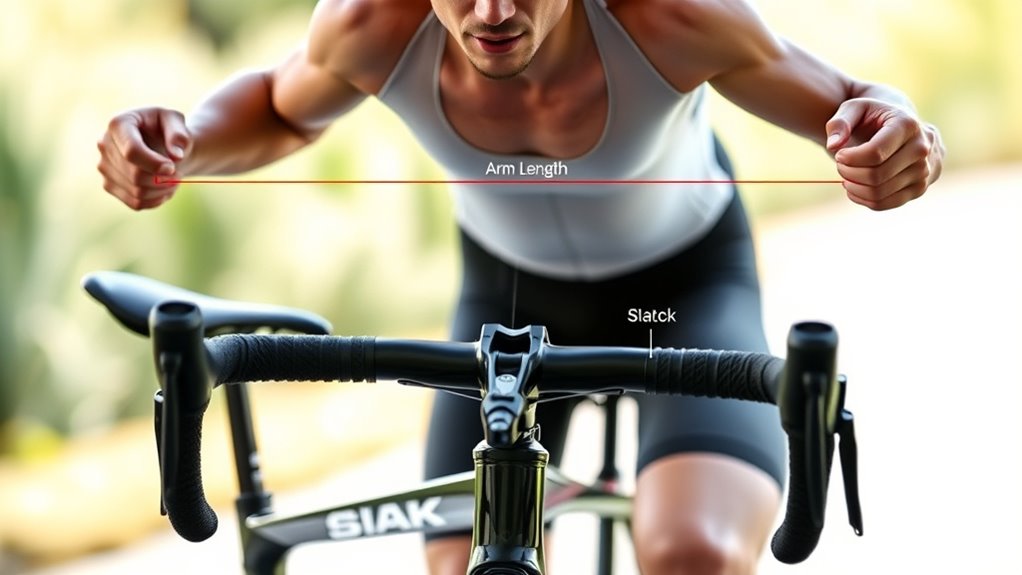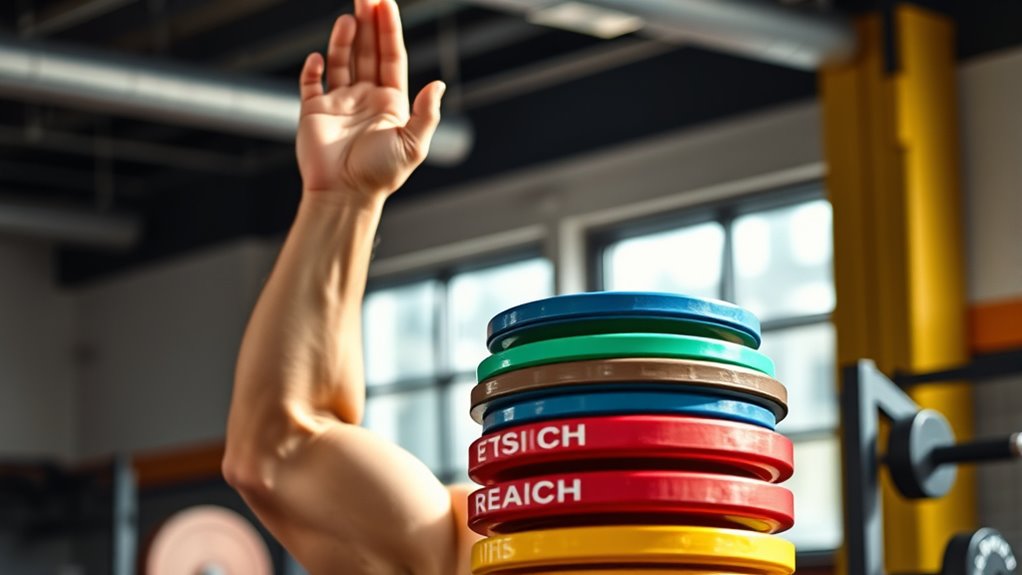Reach and stack are key measurements that help you understand your bike’s fit by defining the horizontal and vertical distances within your frame. Reach affects how stretched out you feel, while stack determines your handlebar height. Properly measuring these can improve comfort, control, and performance. Adjustments with stems and spacers can fine-tune your setup within these limits. Keep exploring to discover how these numbers shape your ideal ride position and bike choices.
Key Takeaways
- Reach measures the horizontal distance from the bottom bracket to the top of the head tube, indicating how far forward the rider sits.
- Stack represents the vertical distance from the bottom bracket to the top of the head tube, affecting the rider’s upright position.
- Accurate measurement involves aligning the bike diagonally against a wall, using a plumb line and tape for precision.
- These measurements influence bike fit, comfort, aerodynamics, and handling, guiding adjustments with stems and spacers.
- Comparing reach and stack across models helps riders select bikes that match their ergonomic and performance needs.
What Are Reach and Stack?

Have you ever wondered how bike frames are measured to guarantee a perfect fit? Reach and stack are the key measurements that do just that. Reach is the horizontal distance from the center of the bottom bracket to the top of the head tube, while stack is the vertical distance between these two points. These measurements help determine how the handlebars will position you relative to your pedals, directly impacting comfort and handling. Introduced in the early 2000s by brands like Cervelo and Trek, they simplify comparing different frames without focusing on tube lengths or angles. Using accurate measurements like reach and stack can also improve the performance and fit of your bike. Additionally, understanding these measurements can support organized space by helping you choose bike storage solutions that fit your environment and decluttering your garage or storage area. Knowing how these measurements relate to frame geometry can further assist in selecting the right bike for your riding style and ergonomic needs. Incorporating creative practice principles can also enhance your approach to customizing bike setups to better suit your personal preferences and needs. Moreover, precise measurements can aid in adjusting riding posture, ensuring a more comfortable and efficient riding experience.
How Are These Measurements Taken?

To accurately measure reach and stack, you need the right tools and proper positioning. Place your bike diagonally in a room corner, with the rear tire and handlebar touching the walls. Use a plumb line, level, and measuring tape for precise readings. Understanding gold investments can help inform your choices when selecting the right measurements for optimal fit. Additionally, employing vertical storage solutions can assist in maintaining consistent positioning during measurement. Align the bottom bracket center with the corner intersection as a reference point. Mark the head tube center on the wall for consistent measurements. For stack, measure vertically from the bottom bracket center to the top of the head tube, ensuring the bike is level with a bubble level. Confirm the bike’s level and parallel alignment with the ground. Ensuring proper measurement technique is followed is crucial for accuracy and repeatability, especially when using advanced fitting tools. Record all measurements in millimeters to ensure accuracy and compatibility with professional fitting tools.
Why Do Reach and Stack Matter in Bike Fitting?

Understanding why reach and stack matter in bike fitting is essential because these measurements directly determine your bike’s fit and overall performance. Your frame’s geometry sets the maximum handlebar position, influencing your comfort, aerodynamics, and power efficiency. Adjustments like stem length and spacers can refine your position but can’t surpass the limits set by reach and stack. Proper measurements help balance aerodynamics and comfort, preventing strain or instability. A too-extensive reach can cause shoulder and hip discomfort, while a too-short reach may reduce handling stability. Reach and stack also affect weight distribution, steering responsiveness, and overall control. Knowing the hours of local supermarket chains can help you plan your shopping trips more efficiently.
The Role of Cockpit Components in Effective Reach and Stack

Cockpit components play a crucial role in fine-tuning your bike’s effective reach and stack, allowing you to customize your riding position beyond the frame’s inherent geometry.
Adjusting stem length and angle directly influences how far forward or upward you sit; shorter stems reduce reach, while upward angles increase stack.
Handlebar sweep and rise also matter—backsweep bars bring grips closer, decreasing reach, while higher-rise bars add vertical height.
Spacers can increase stack without changing the frame, but integrated cockpits limit adjustments.
The position of shifters and hoods further affects reach, with forward-mounted controls extending it and rearward positions reducing it.
Compatibility and modern proprietary designs help optimize these adjustments, giving you a tailored fit that balances comfort and performance.
How Reach and Stack Differ From Traditional Frame Sizes

Traditional bike sizing relies on seat tube length, which varies markedly across brands and models, making direct comparisons difficult.
Reach and stack measure different aspects of a bike’s geometry—reach is the horizontal distance from the bottom bracket to the head tube, while stack is the vertical height from the bottom bracket to the top of the head tube.
These measurements focus on cockpit positioning rather than seat tube length, which can be affected by seat angle and frame style.
Unlike traditional sizes, reach and stack enable consistent comparisons across brands, regardless of frame design. They prioritize rider fit by highlighting how the bike positions you in the saddle and handlebars.
This approach reduces reliance on seat tube length, which often misleads fit assessments, especially with modern sloping top tubes and varied geometries.
Practical Uses of Reach and Stack in Choosing and Adjusting Bikes

Knowing how to use reach and stack measurements allows you to make precise adjustments to your bike for a better fit. By understanding reach, you can modify the handlebar position with stem length or angle, ensuring you’re not overstretching or feeling cramped.
Adjusting handlebar height through spacers or risers changes the stack, influencing your riding posture and comfort. If you feel too upright or too stretched out, you can fine-tune the fit by adding or removing spacers or switching stems.
Changing seat height impacts your perceived reach, but actual reach depends on frame geometry. These adjustments help optimize pedaling efficiency, improve control, and reduce fatigue, ensuring a more comfortable and effective riding experience tailored to your body and riding style.
Comparing Bikes Using Reach and Stack Metrics

When comparing different bike models, understanding their reach and stack measurements is essential for finding a frame that fits your body and riding style. These metrics help you see how the frames differ in rider positioning, comfort, and performance.
Reach measures how far forward you sit, while stack indicates how high the handlebars are relative to the bottom bracket. Variations across sizes and brands can considerably affect fit, so comparing these numbers helps you choose the right frame.
Tools like geometry charts and databases make it easier to visualize differences. Remember that manufacturer-specific sizing charts may vary, and bike categories influence geometry priorities.
Adjustments like stems and spacers can fine-tune reach and stack, but understanding the baseline comparisons ensures you select a frame aligned with your riding needs.
Frequently Asked Questions
How Do Reach and Stack Influence Overall Riding Comfort?
Reach and stack directly impact your riding comfort by shaping your posture and control. When reach is too long or short, you strain your neck, shoulders, and wrists.
Proper stack guarantees your hips stay open and your back remains relaxed, reducing fatigue. Balancing both allows you to maintain a comfortable, efficient position, whether upright for endurance or aero for racing, preventing discomfort and improving overall ride quality.
Can Reach and Stack Measurements Predict Bike Handling Characteristics?
You wonder if reach and stack measurements can predict how a bike handles. These measurements influence rider positioning, weight distribution, and steering feel.
A longer reach and lower stack give a more aggressive, aerodynamic stance, which may reduce stability on rough terrain. Conversely, shorter reach and higher stack promote control and comfort.
While they provide useful clues, handling also depends on other factors like geometry, components, and rider skill.
Are Reach and Stack Suitable for Customizing Fit for Different Rider Sizes?
Think of your bike fit like tailoring a suit. Reach and stack are the pattern measurements that help you customize your ride for a perfect fit. They’re precise tools that let you compare bikes across brands and adjust components to match your body.
How Do Stem Length and Spacers Affect Effective Reach and Stack?
When you adjust stem length and spacers, you change your bike’s reach and stack. A longer stem increases reach, pushing you forward, while a shorter stem makes steering quicker.
Adding spacers raises your handlebars, increasing stack for a more upright position. Removing spacers lowers the handlebars, decreasing stack for a sportier feel.
These adjustments help you customize your fit for comfort and performance based on your riding style.
Do Reach and Stack Measurements Stay Consistent Across Different Bike Brands?
You wonder if reach and stack stay consistent across brands. They don’t always, due to differences in frame geometry, seat tube angles, and suspension setups—especially on mountain bikes.
But, using standardized methods and online tools helps you compare these measurements more accurately.
Adjustments like stem length and spacers can also influence your fit.
Conclusion
Think of reach and stack as the compass guiding your perfect ride. Like a skilled sailor adjusting sails to catch the wind just right, understanding these measurements helps you navigate bike fit with confidence. When you find that ideal balance, every pedal stroke becomes a smooth journey, and the road ahead feels endless. Embrace these metrics as your trusted map—your adventure awaits, and the perfect fit is within your grasp.
















